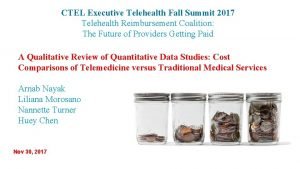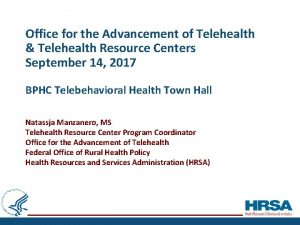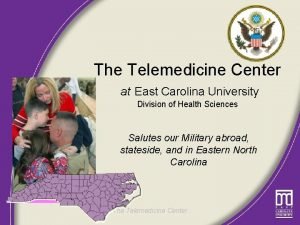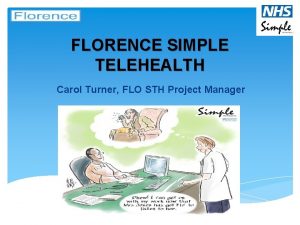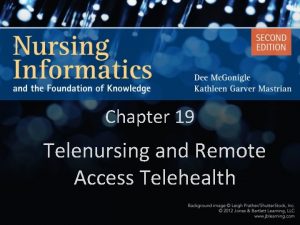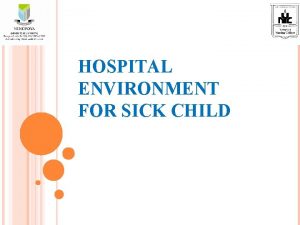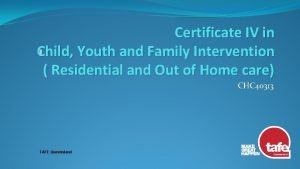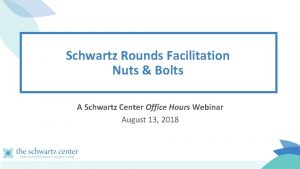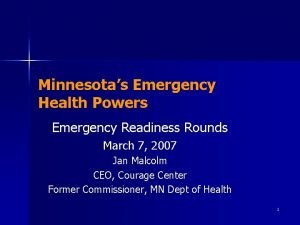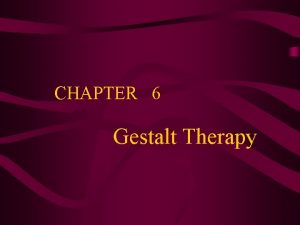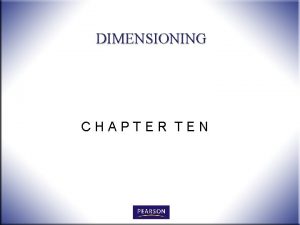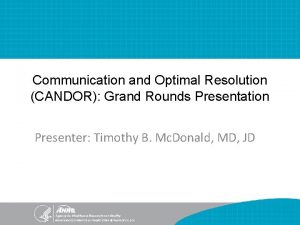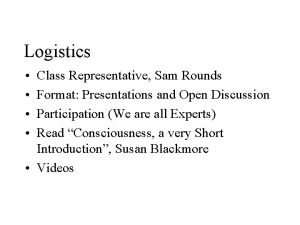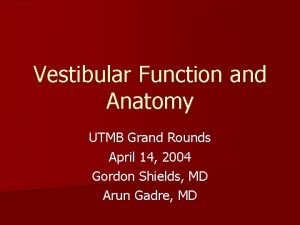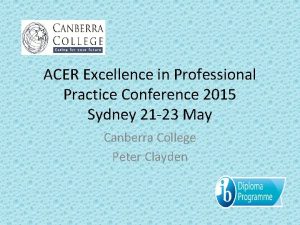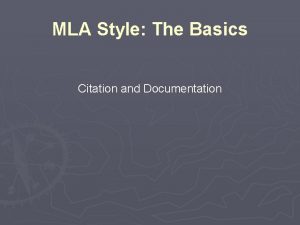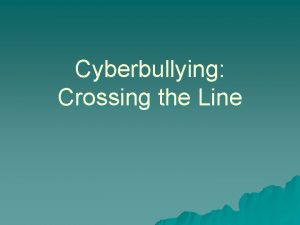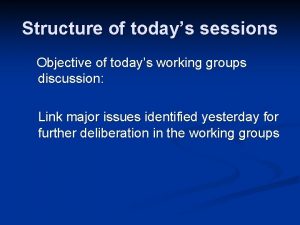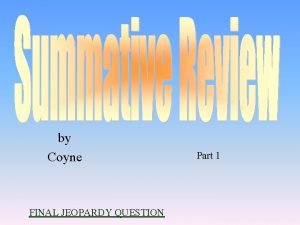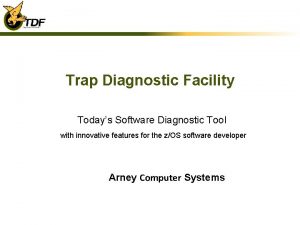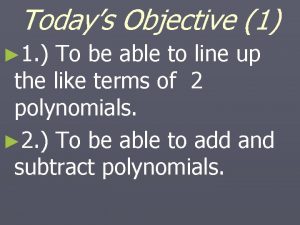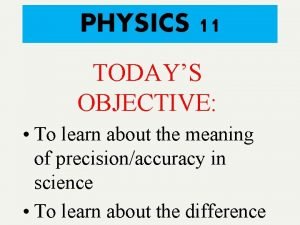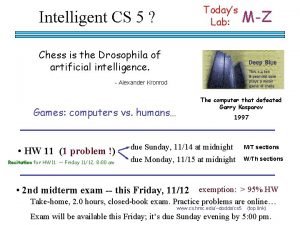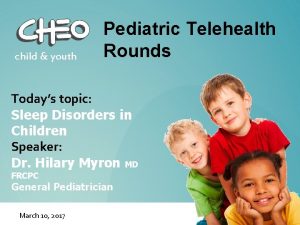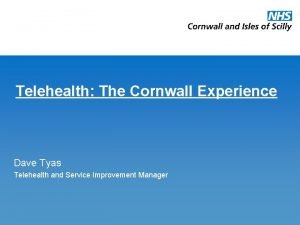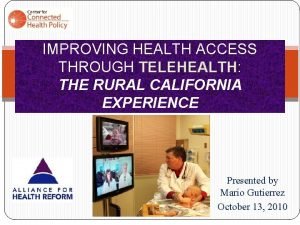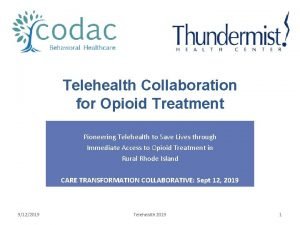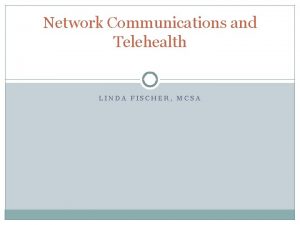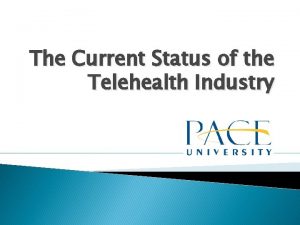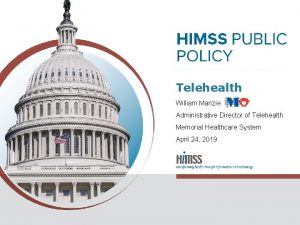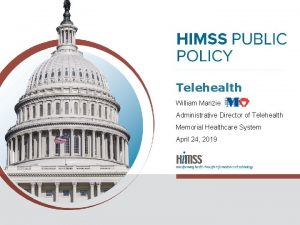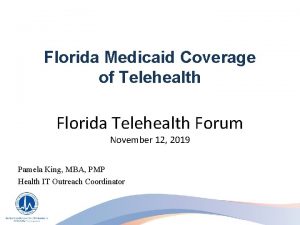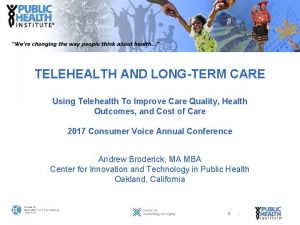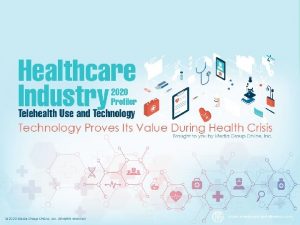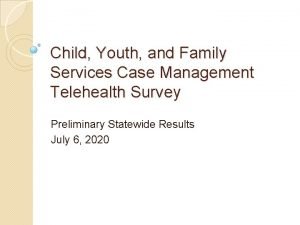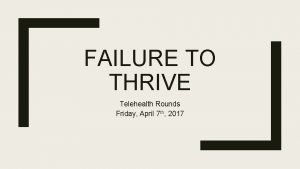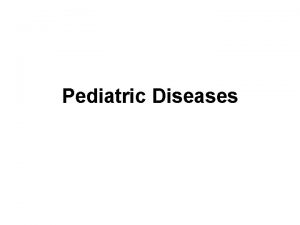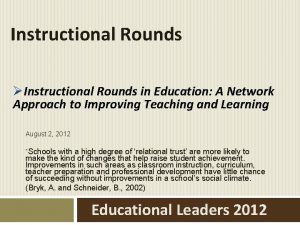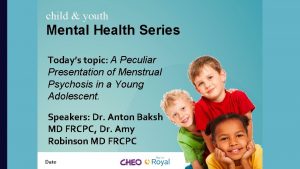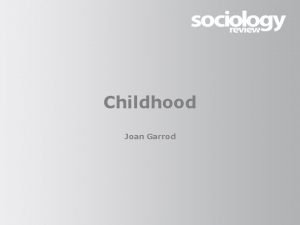child youth Pediatric Telehealth Rounds Todays topic Childhood























































- Slides: 55

child & youth Pediatric Telehealth Rounds Today’s topic: Childhood Scoliosis Speaker: Faye Goldman MD Jessica Romeo NP February 19, 2016

If you are connected by videoconference: Please mute your system while the speaker is presenting. Complete today’s evaluation & apply for professional credits

Please feel free to ask questions! Complete today’s evaluation & apply for professional credits

You will have had an opportunity to apply By for professional credits or a certificate of registering attendance for today’s You will receive an email with a link to event… today’s online evaluation You may also want to… Visit our website to download slides and view archived events Sign-up to our distribution list to receive our event notifications Questions? pedtelehealthrounds@cheo. on. ca

Speaker has nothing to disclose with regard to commercial support. Declaration of conflict Speaker does not plan to discuss unlabeled/ investigational uses of commercial product.

Childhood Scoliosis Presentation Faye Goldman MD Jessica Romeo NP 2016

Objectives � To identify the various causes of scoliosis in the pediatric population � To identify the important elements of the history and physical exam, and relevant imaging needed in the work -up of scoliosis � To identify referral and management options: Orthopaedics, physiotherapy scoliosis specific exercises (PSSE), part time/full time bracing, and surgery

Organizations that are Committed to Scoliosis Research: Society On Scoliosis Orthopedic and Rehabilitation Treatment 2004 Scoliosis Research Society 1966 International Research Society of Spinal Deformities 1994 IRSSD www. Irssd. org patient SOSORT www. sosort. mobi SRS www. srs. org

The objective of this presentation is to prevent the late diagnosis of scoliosis and ultimately decrease the need for spinal fusion surgery by offering timely non-surgical treatment options.

Scoliosis Definition � Scoliosis is defined as a lateral curvature of the spine. It is a 3 dimensional deformity. � Scoliosis is diagnosed when curve is greater than 10°, as measured on a posteroanterior (P/A)spine film. � Structural (Adam’s Forward Bending Test positive) � Involves an element of rotation within the spine and ribcage, in addition to the lateral curvature. � Non-Structural (Adam’s Forward Bending Test negative) � Postural or other asymmetries mimicking scoliosis and its symptoms

Normal Spine A/P, Lat, P/A

Scoliosis Classification � Congenital � Neuromuscular � Idiopathic

Congenital Scoliosis �Caused by a deformity in the development of the vertebral column in utero � Abnormal � Involves development occurs by 6 weeks of GA either failure of formation, or failure of segmentation

Congenital Scoliosis Defects of Segmentation

Congenital Scoliosis �Although skeletal abnormality present at birth, may take time for scoliosis to develop as spine grows �Abnormality may be found on prenatal U/S

Congenital Scoliosis � Other organ systems are often involved and a work up is necessary � � � Neurologic Cardiac Renal/Genitourinary Work up includes thorough exam, MRI, echo and abdominal U/S. Early referral to orthopaedics as well as any other services as needed. 2040% of patients have abnormal MRI including intraspinal anomaly Organ systems that develop at the same gestational time (fifth to sixth week) may also demonstrate abnormalities in up to 60% of cases

Neuromuscular Scoliosis � Symptoms vary: spasticity, weakness, low muscle tone � Syndromes or neuromuscular conditions causing scoliosis include: � Cerebral Palsy � Muscular Dystrophy � Spinal Muscular Atrophy � Neurofibromatosis � Myelomeningocele � Ehlers-Danlos Syndrome � Marfan syndrome � Osteogenesis Imperfecta � Achondroplasia

Neuromuscular Scoliosis � Early detection is important as early intervention may help improve function and delay progression. � Function can include: ambulation, positioning in wheel chairs, prevention of pressure ulcers, and cardiopulmonary function

Idiopathic Scoliosis • Most common type • 30% of cases run in families • 10% of children diagnosed will need some sort of treatment: bracing- full or part time, scoliosis specific physiotherapy, or spinal fusion surgery.

Idiopathic Scoliosis Idiopathic = cause unknown � Idiopathic scoliosis (IS) is a diagnosis of exclusion � Idiopathic scoliosis is sub-divided by age into infantile (0 -3 years), juvenile (3 -10 years), adolescent (>10 years) and adult (18+ years) � Adolescent Idiopathic Scoliosis (AIS) is the most common form of all scoliosis in the pediatric population (80%)

Adolescent Idiopathic Scoliosis (AIS) � Etiology: multifactorial � Includes genetic and environmental factors � Incidence: roughly equal between males and females � Higher risk of progression in females (8: 1) � Prevalence: 2 -4% of teen population

Idiopathic Scoliosis � The primary concerns regarding scoliosis often involve activities of daily living, as well as aesthetic appearance � When the scoliosis angle increases over 70 degrees, other organ systems can be affected � Pulmonary function � Cardiac function

Idiopathic Scoliosis �In general, the following rules apply to skeletally mature (Risser 5) individuals: � Curves less than 30° are less likely to progress � Curves greater than 50° are more likely to progress into adulthood � The general rate of progression for adults is 1° per year � There is a fast progression during the rapid growth phase of puberty that can reach up to 2 -5 degrees per month

AIS Main Curve Patterns (Weinstein, Natural History of Scoliosis ) Thoracic Thoraco-Lumbar Double Major

Why Do We Treat AIS? What we want to obtain and to avoid for our patients � Aesthetics � Quality of Life � Avoid Disability � Psychological well being � Back pain � Reduce need for treatment in adulthood � Posture balance and movement related outcomes Negrini S, Grivas TB, Kotwicki T et al. Why do we treat adolescent idiopathic scoliosis? What we want to obtain and to avoid for our patients. SOSORT 2005 Consensus paper. Scoliosis. 2006; 1: 4.

Risk of Progression of Scoliosis

Time of Progression of IS � Progression of the scoliosis occurs at times of highest growth velocity

History Important to elicit the following: �Onset and clinical progression �Presence of neurologic symptoms �Back pain, trauma, injury, effect on activity �Puberty and remaining growth potential �Pregnancy history �Past medical history �Family history

Physical Exam � General Exam: � Growth parameters � Height, Weight, HC, BMI � Important to plot all parameters on standardized growth curve � Arm Span � Tanner Staging � Skin exam � Pigmentation, sacral dimple, hair tuft, myelomeningocele, lipoma, skin/joint laxity � Leg Length Discrepancy

Physical Exam � Neurologic Exam � Gait � Balance � Reflexes (DTR and other) � Motor � Sensory � Cranial � Cardiac Nerves and Respiratory exam

Physical Exam � Scoliosis specific � Must have adequate exposure of trunk, including shoulders and iliac crest. � Inspect for symmetry in height of the shoulders as well as the iliac crests. � Inspect for position of hands when hung at sides � Inspect for asymmetric skin creases on lateral abdominal wall � Position of head over sacrum

Physical Examination � Adam’s Forward Bend test (AFBT) � Patient bends forward at waist, with knees kept straight, and palms together � Examine for asymmetry between the left and right side � Due to the rotational component of the scoliosis � The more prominent side is associated with the convex curve of the spine Source: Christa Lehnert Schroth

Adam's Forward Bending Test (AFBT) Source: CHEO

Bunnell Scoliometer • Can be used as part of physical exam to detect rotational deformity • Any deviation greater than 5 -7° should be referred to Orthopedics

Scoliosis Screening on Physical Examination Source: CHEO

Imaging � For evaluation of scoliosis, a 3 foot standing P/A film of the entire spine is needed. Often scoliosis series films are ordered and unfortunately include many views that are non-essential to the diagnosis. � Lateral standing radiograph can be added to rule out spondylolisthesis and spondylolysis � Other images that can be useful: � Leg length study to detect for discrepancy as a potential cause for scoliosis � In the case of congenital scoliosis – echocardiography and abdominal ultrasound to detect multi-organ involvement.

Radiograph Cobb Angle Measurement �Cobb Angle Used to measure the degree of curvature within a segment of the spine � <10 degrees = spinal asymmetry � >10 degrees = true scoliosis � >25 degrees & <45 degrees = consider bracing � >45 -50 degrees = consider surgery depending on maturity of child and risk of progression � Risk of progression is dependent on bone maturity, menstrual status, and curve magnitude �

MRI � MRI is useful as it provides additional information regarding underlying anatomy without radiation exposure � Indications for MRI include: Age at onset (congenital or infantile, under age 10) � Abnormal Neurologic exam � Rapidly progressing curve � Left thoracic curve � Consider MRI if scoliosis is painful �

Where to Refer for Imaging? When referring patient for X-Ray it is best to send to the local hospital where the specialist may see them in the future, to avoid repeated X-Rays.

When to Refer to a Specialist? � Refer to Orthopaedics for the following: Any congenital scoliosis � Any curve greater than 15 -20° and growth remaining � Any rapidly progressing curve � Any patient with a left thoracic curve � Neurologic abnormality � Significant pain � Family history and curve >10 degrees � When not to Refer ? Skeletally mature teens with small curves, under 25° � Example: 16 year old girl with 15° scoliosis �

Non-Surgical Treatment Bracing Physiotherapy Scoliosis Specific Exercises (PSSE)

Bracing Treatment � The goal of bracing is to prevent further progression of the scoliosis and to prevent need for surgery � Early diagnosis and early bracing can decrease the number of surgeries. Ideal degrees to brace a skeletally immature child is 25° according to SRS guidelines � Thought to be inefficient in curves >50° � Efficacy is increased with more time spent in the brace, compliance is key � Suggested to combine bracing with scoliosis specific physiotherapy exercises (PSSE) according to SOSORT guidelines

Scoliosis Research Society Bracing Guidelines for IS Based on RISSER and Curve Magnitude Indication of Treatments Sourse SRS

The Effectiveness of Bracing BRAIST Study (2013) � The success of bracing in preventing the need for surgery was 72 percent, compared to the observation group at 48 percent, in BRAIST study. � Bracing proved to be so effective in reducing the teens’ need for eventual surgery that the trial was halted mid-way through, says co-author Dr. James Wright Surgeon-in-Chief at Sick. Kids hospital

“Now we can say with confidence that BRACING PREVENTS THE NEED FOR SURGERY. ” Weinstein SL

Schroth Physiotherapy Exercises "PSSE, Schroth PT is beneficial when combined with current care" RCT published by University of Alberta When to refer to scoliosis specific physiotherapy • • before and after surgery, during observation period during bracing treatment If bracing or surgery refused Source: Ottawa & District Physiotherapy Clinic Scoliosis Physiotherapy & Posture Rehabilitation

Surgery � Goal for surgery is to correct the curve, stop progression, and improve aesthetic appearance of the back � Treatment for moderate scoliosis, if progression would result in aesthetic or physiologic and function abnormalities � Most infantile and juvenile scoliosis patients require spinal fusion surgery

Surgery � There are various surgical techniques and approaches � Growing rods can be placed to correct the scoliosis and allow the patient to continue growing. This is typically used in young children with Juvenile Scoliosis. � For Adolescent Idiopathic Scoliosis, the spine is fused with rods, screws and donor bone to ensure stabilization

Spinal Fusion Surgery for AIS • 6 -8 hours long • Pain management • 3 -4 days in hospital • 6 month activity restrictions

Take home message You can make a difference! Screening for scoliosis leads to early detection and treatment, which reduces the need for surgery. Please add scoliosis screening to your checklist when you see teens between the ages 10 -14 years of age. � When Adam’s test is positive in a skeletally immature child monitor closely and refer. � Adding a scoliometer to your physical exam can help screen for scoliosis and monitor patients. � Send for X-Rays (3 Foot PA +/- LAT) at the center in which you plan on referring to. � Refer to Orthopaedics if: the Cobb angle on X-Ray is greater than 15 degrees on a skeletally immature patient. � Monitor if: the Cobb angle is less than 15 degrees. Followup radiographs can be done at 4 -6 month intervals depending on skeletal maturity �

Scoliosis Support � Emotional and psychosocial component of scoliosis � Patients and parents can often benefit form support groups � Curvy Girls Scoliosis Support groups � Ottawa, Timmins, Toronto, etc. � contact: curvygirlsottawa@gmail. com � visit: www. curvygirlsottawa. ca

References � Campos MA, Weinstein SL. Pediatric Scoliosis and Kyphosis. Neurosurg Clin N Am. 2007; 18: 515 -529. � Janicki JA, Alman B. Scoliosis: Review of diagnosis and treatment. Paediatr Child Health. 2007; 12(9): 771 -776. � Khanna G. Role of imaging in scoliosis. Pediatr Radiol. 2009; 39: S 247 -S 251. � Rosenberg JJ. Scoliosis. Pediatrics in Review. 2011; 32(9): 397 -398. � Scheri SA. Clinical features; evaluation; and diagnosis of adolescent idiopathic scoliosis. In: Up. To. Date, Phillips W, Torchia MM (Ed), Up. To. Date, Waltham, MA, 2013. � Spiegel DA, Dormans JP. The Spine. In: Kleigman RM, Stanton BF, St. Geme JW, Schor NF, Behrman RE, Editors. Nelson Textbook of Pediatrics. Philadeplphia, PA: Elsevier Saunders; 2011. p 2365 -2377. � Parent S, Newton PO, Wenger DR. Adolescent idi- opathic scoliosis: Etiology, anatomy, natural history, and bracing. Instr Course Lect 2005: 54: 529– 536. � Adobor RD, Joranger P, Steen H, Navrud S, Brox JI. A health economic evaluation of screening and treat- ment in patients with adolescent idiopathic scoliosis. � Scoliosis 2014; 9: 21. Doi: 10. 1186/s 13012 -014 -0021 -8. e. Collection 2014. � Weinstein SL, Dolan LA, . Wright JG, Dobbs MB. Effects of Bracing in Adolescents with Idiopathic Scoliosis N Engl J Med 2013; 369: 1512– 21. DOI: 10. 1056/NEJ- Moa 1307337 � Sanja Schreiber, Eric C. Parent, Elham Khodayari Moez, Douglas M. Hedden, Doug Hill, Marc J. Moreau, Edmond Lou, Elise M. Watkins and Sarah C. Southon The effect of Schroth exercises added to the standard of care on the quality of life and muscle endurance in adolescents with idiopathic scoliosis—an assessor and statistician blinded randomized controlled trial: “SOSORT 2015 Award Winner” Scoliosis 2015 10: 24 � Beauejour M, Goulet L, Parent S, Feldman DE, Turgeon I, Roy-Beaudry M, Sosa JF, Labelle H. The effectiveness of scoliosis screening programs: methods for sys- tematic review and expert panel recommendations formulation. Scoliosis 2013; 8: 12. http: //www. scoliosis- journal. com/content/8/1/12 � Richards BS, Vitale MG. Screening for Idiopathic Scoliosis in Adolescents. An information Statement. J Bone Joint Surg Am. 2008; 90: 195– 198. Doi: 10. 2106/ JBJS. G. 01276 � US Preventive Services Task Force: The Guide to Pre- ventive Services 2012, Recommendations of the US Preventive Services Task Force. http: //www. ahrq. gov/ professionals/clinicans-providers/guidelines-recom- mendations/guide-clinical-preventiveservices. pdf � Canadian Task Force on Preventive Health: New grades for recommendations from the Canadian Task Force on Preventive Health Care. CMAJ 2003; 169: 207– 208. � Kuru, T. , Yeldan, I. , Dereli, E. E. , Ozdincler, A. R. , Dikici, F. , Colak, I. (2015) The efficacy of three-dimensional Schroth exercises in adolescent idiopathic scoliosis: A randomised controlled clinical trial. http: //www. ncbi. nlm. nih. gov/pubmed/25780260 � Monticone, M. , Ambrosini, E. , Cazzaniga, D. , Rocca, B. , Ferrante, S. (2014) Active self-correction and task-oriented exercises reduce spinal deformity and improve quality of life in subjects with mild adolescent idiopathic scoliosis. Results of a randomised controlled trial. http: //www. ncbi. nlm. nih. gov/pubmed/24682356

Managing Adolescent Idiopathic Scoliosis (AIS) in Primary Care Moroz, P. , Romeo, J. , Abouassaly, M. (2015) Journal of Current Clinical Care http: //www. healthplexus. net/files/content/2015/0503 scoliosis. pdf#view= fit. V&pagemode=thumbs

Questions or Comments? Video-conferencers: Unmute&your to Complete today’s evaluation applysystem for professional credits ask a question Webcasters: Type your question

Thank you! for participating in today’s Pediatric Telehealth Rounds Join us next time: Eczema & Other Skin Conditions Dr. S. Davenport March 4, 2016 pedtelehealthrounds@cheo. on. ca
 Ctel telehealth
Ctel telehealth Office for the advancement of telehealth
Office for the advancement of telehealth Telehealth and telemedicine
Telehealth and telemedicine Flo telehealth
Flo telehealth Telenursing and remote access telehealth
Telenursing and remote access telehealth Middle childhood and adolescence
Middle childhood and adolescence The sick child ppt
The sick child ppt Examples of clinchers
Examples of clinchers Narrow topic examples
Narrow topic examples Child youth and family services act
Child youth and family services act Cert iv in child youth & family intervention
Cert iv in child youth & family intervention Maintenance rounds
Maintenance rounds Red white and blue tortilla chips
Red white and blue tortilla chips Christmas table quiz seomra ranga
Christmas table quiz seomra ranga Duke medicine grand rounds
Duke medicine grand rounds Schwartz rounds facilitator training
Schwartz rounds facilitator training Readiness rounds
Readiness rounds Five layers of neurosis
Five layers of neurosis Rounds and fillets are usually dimensioned using
Rounds and fillets are usually dimensioned using Nursing grand rounds presentation example
Nursing grand rounds presentation example Sam rounds
Sam rounds Utmb grand rounds
Utmb grand rounds Anatomy of a bullet
Anatomy of a bullet A is an odd number which rounds to 100 000
A is an odd number which rounds to 100 000 Quality teaching rounds coding sheet
Quality teaching rounds coding sheet 75 round off
75 round off Richard elmore harvard
Richard elmore harvard 전위 순회
전위 순회 Swine digestive system
Swine digestive system Mla cover page
Mla cover page Todays objective
Todays objective 25 creative ideas for sabbath school
25 creative ideas for sabbath school Clients often criticize public relations firms for:
Clients often criticize public relations firms for: Todays generations
Todays generations Todays worldld
Todays worldld Adam smith jeopardy
Adam smith jeopardy Todays agenda
Todays agenda Todays objective
Todays objective Todays objective
Todays objective Todays vision
Todays vision Todays jeopardy
Todays jeopardy Chapter 13 marketing in todays world
Chapter 13 marketing in todays world Geographic regions final jeopardy
Geographic regions final jeopardy For today's meeting
For today's meeting Todays objective
Todays objective Todays final jeopardy question
Todays final jeopardy question Final jeopardy 2/2
Final jeopardy 2/2 Walsall rfc
Walsall rfc Todays price of asda shares
Todays price of asda shares Today's class work
Today's class work What is todays temperature
What is todays temperature Todays software
Todays software Date frui
Date frui Todays objective
Todays objective Todays objective
Todays objective Todays lab
Todays lab
